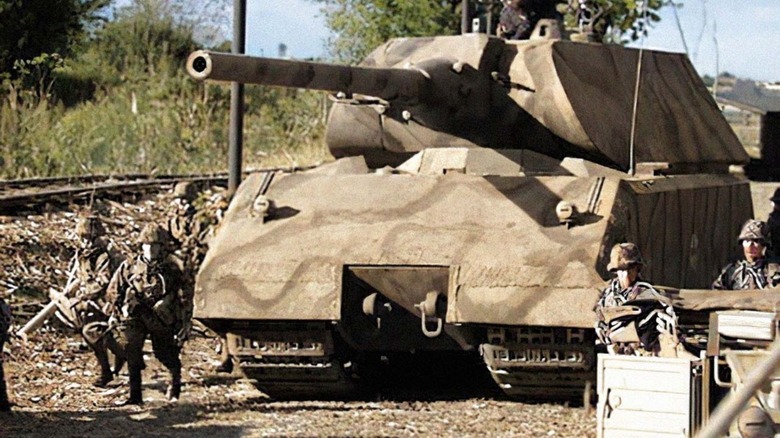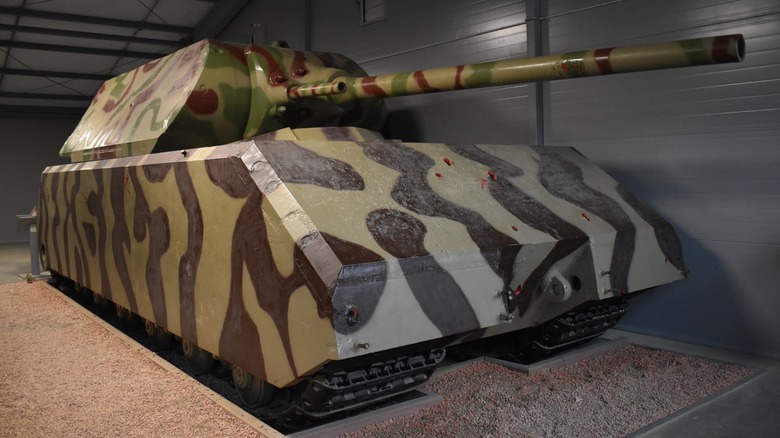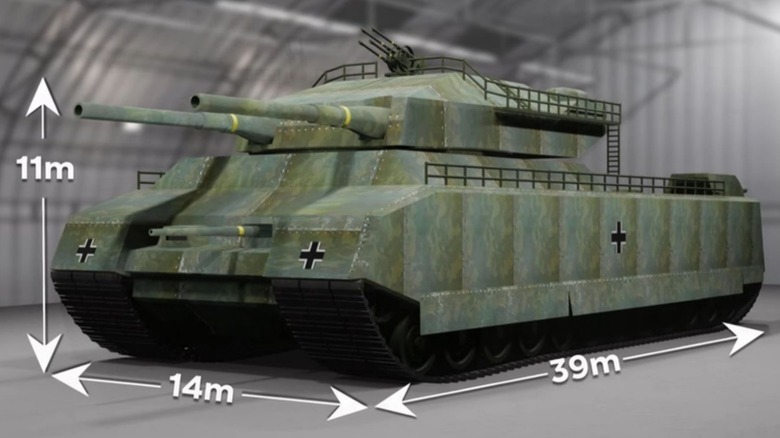This Is The Largest Military Tank Ever Made
Tanks have been around since World War I, and by necessity, they've always been large, heavy military machines. Their tremendous size and weight come from the thick armor plating affixed to various parts of the body. Like any military technology, tanks of all different sizes have been built over the years, and while there's some interest in the smallest armored offering, the largest military tanks ever built are far more interesting to the average person. While many nations have toyed with developing massive tanks, the Third Reich of World War II built some of the craziest military machines.
Some of these included humongous tanks, many of which were constructed, while others never entered the manufacturing stage. The largest of these tanks is, by far, the largest military tank ever made: the Panzer VIII Maus. The Maus, which is German for "mouse," was truly huge, weighing in at a whopping 188 tons, making its name somewhat confusing. Mice aren't typically associated with the biggest and heaviest examples of things, but the tank was given the codename Little Mouse (Mäuschen) during development, and it stuck.
The tank holds the distinction of being the heaviest operational tank ever made, but it never saw combat. Their introduction came late in the war, and by the time two prototypes had rolled off the assembly lines, the required testing needed to continue production commenced but never completed. Some captured parts still exist in Russian and British museums, but for the most part, the Panzer VIII Maus is a story of excess and poor planning.
The Panzer VIII Maus
The Panzer VIII Maus is more than the largest tank ever built — it's an engineering marvel. Considering the amount of power needed to move 188 tons on land, it's almost impossible to imagine it actually worked. While the Maus did function, it didn't do so to the standards required of combat. Building it so massive was the problem, as it required 1.48 gallons of fuel to move one mile. That's a fuel economy rating of only 0.6 mpg. When moving on paved surfaces, the Maus could reach 13.6 mph, and it could ford water that was up to 25.9 feet deep using a snorkel.
The two tanks that were constructed, known as V1 and V2, featured similar engines. The second used was a Daimler Benz MB 517 V-12 Petrol 1,200 hp at 1,500 rpm engine. An additional 8 hp engine provided power for pressurizing the tank, air conditioning, heating, gas filtration, and battery charging, which was used for snorkeling. One of the primary reasons for the slow speed and awful fuel economy was the tank's weight of 188 tons.
This was brought about via its massive dimensions and armor. The Maus measured 33 feet long, 12.1 feet wide, and 11.97 feet high. While some of the tank's armor was relatively thin on the turret roof, measuring 2.36 inches, much of the hull armor was between 3.93 inches and 8.07 inches thick. During development, the turret weighed 62.8 tons, which is incredibly massive. For comparison, the modern M1A2 Abrams Main Battle Tank weighs 68 tons, and that's for the turret, body, ammunition, and everything else.
The Largest Tank Design That Never Came To Fruition
While the Panzer VIII Maus was a massive beast of a tank and the largest ever constructed, It wasn't the biggest the Nazis planned to produce. That would be the Krupp Landkreuzer P.1000 Ratte (Rat), and it was one of Germany's worst-designed tanks. The name gives away the prize because the Landkreuzer (Land Cruiser) P.1000 would have weighed 1,102.3 U.S. tons. The plan was canceled in 1943, leaving production to focus on the comparatively light Panzer VIII Maus.
It's difficult to comprehend just how massive this tank would have been because there are few modern vehicles that come close to 1,000 tons. Any that do are NASA crawlers used to transport rockets to launch pads, but no tank has ever approached 1,000 tons outside of the Maus. The main draw for the Ratte was that it would have sported dual 11-inch battleship guns as its primary weapon. These would have been joined by a pair of 5-inch guns and multiple machine guns provided from Naval stockpiles maintained by Krupp.
The vehicle's weight breakdown during the development phase in October 1942 was as follows: armament = 330 tons, armor = 220 tons, frame = 200 tons, tracks = 110 tons, and the machinery within the tank weighed 110 tons. The tank required three separate tracks on each side just to move it, which explains the 110-ton weight. It's hard to imagine how much fuel this tank would have consumed, but odds are, it was faster, easier, and more cost-effective to build much smaller tanks for the war.


